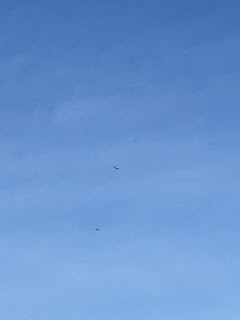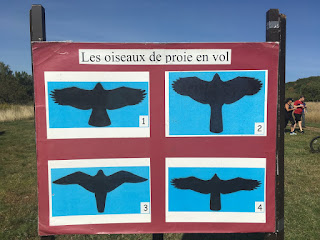There were taxodermy models, posters and binoculars (jumelles). There was a whole new vocabulary to learn.



Can you tell the differences in the silhouette?
La crécerelle d'Amérique is the smallest, also known as the kestrel. We know it from Granby Zoo and the Forestry Farm as an endangered species.
Le faucon émerillon is a merlin.
Le faucon gerfaut is the gyrfalcon, the largest falcon.
Le Faucon pèlerin is the peregrine falcon.
Le Pygargue à tête blanche is the bald eagle.
L'aigle royal is the golden eagle.
L'urubu à tête rouge is the turkey vulture.
Le balbuzard pêcheur is the osprey.
La buse à queue rousse is the red tailed hawk.
La buse à épaulettes is the red shouldered hawk.
La petite busse is the broad-winged hawk.
La buse pattue is the rough-legged hawk.
Le busard Saint-Martin is a hen harrier. Its genus is Circus, from the circling behaviour common to birds of prey.
L'épervier de Cooper is Cooper's hawk.
These are all birds we can see in eastern North America.
The eight highlighted in orange were the diurnal ones to look for in Quebec.
Mostly, we saw vultures and crows!
SPOILER ALERT!
1. Buse/Hawk
2. Epervier/Eagle or sparrow hawk
3. Faucon/Falcon
4. Urubu/vulture
No comments:
Post a Comment